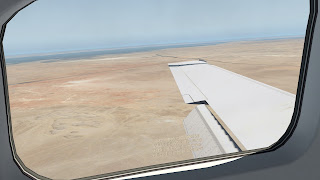It was a clear morning with calm winds, perfect to explore the famous land of the Ancient Egypt. Four passengers were looking for transportation towards Aysut and, after showing them my idea for the flight, they agrees on flying with me. From Alexandria we would fly east towards Port Said. Once there, we would head south following the Suez canal till reaching the city of Suez. Then a turn to west, towards Cairo and, once there, south towards our destination, following the Nile. So we packed our luggage and started the taxi to runway 04.
The take-off was as beautiful as the approach the day before. The views of Alexandria and the surrounding green fields of the Nile delta were stunning, while flying over a large lake next to the airport.
Few miles after heading east, we crossed one of the main terminus of Nile river, being able to spot Rosetta, the location at which the famous stone was found in 1977. The Rosetta Stone, dating from 196 BC was being used as construction material in a fort in Rosetta, later taken by the British to be exposed at The British Museum.
About 100 nm later we were at the opposite side of the Nile delta, approaching Port Said. Port Said was founded on 1859, together with the beginning of the constructions of the Suez Canal. This Canal, pursued since the Pharaonic times, was finally built between 1859 and 1869, using the handworkd of hundreds of thousand forced villagers. Some sources estimate in 125,000 the number of deaths caused during this construction. Afterwards, the Canal was a political instrument controlled mainly by UK, generating friction with Egypt and leading to sinking of boats, blockades and war.
We headed to the south, flying along the 80 nm of the Canal. It's funny to notice how the Canal acts as a border between the Nile Delta and pure desert. Finally we arrived to Suez. This town has been an important port since the medieval ages, specially due to the pilgrimage to Mecca. It was fully destroyed in the late 1960s, on the war between Egypt and Israel, then reconstructed. The vew of the Red Sea in front of us is impressive.
A turn towards 270º took us to Cairo. This section of the flight was all over a desert full of beautiful wavy hill, very different to the flat desert landscape I saw along Tunisia and Libya coasts.
And finally we were over Cairo, the largest city of the Arab world, the whole Africa and the Middle East. A huge city in the beginning of the Nile Delta. It was founded in 969 AD, after a large number of settlements in the area for many years before.
But let's stop the history review for a moment. I was crossing the airspace of Cairo airport when I got by UNICOM the intentions of taking-off of a Boeing 737-800, pointing towards our position. I informed about my position, altitude and intentions, but the Boeing decided to take-off anyway. As a result, we could say hello to each other through our windows (and UNICOM)... Luckily he saw me right on time and made a turn, avoiding a colision.
But let's stop the history review for a moment. I was crossing the airspace of Cairo airport when I got by UNICOM the intentions of taking-off of a Boeing 737-800, pointing towards our position. I informed about my position, altitude and intentions, but the Boeing decided to take-off anyway. As a result, we could say hello to each other through our windows (and UNICOM)... Luckily he saw me right on time and made a turn, avoiding a colision.
I had to turn south, to follow the Nile river upstream, but obviously I didn't want to miss the Great Pyramid of Giza, together with Khafre and Menkaure pyramids and the Great Sphinx. However, X-plane decided that this place was not too interesting and placed an ugly building over them (and forests, and american houses... I don't know how to prevent this).
The last 120 nm of the trip were done along the Nile river, flying at 10500 ft. to save fuel and have better perspective of that green huge kind of snake surrounded by nothing but sand. We flew over Memphis, the old capital of the Ancient Egypt, and the Faiyum Oasis, a green patch on the western side of the river.
Few miles before Asyut, the Nile makes a turn. As soon as I had it on sight, I started the descent, approaching Asyut airport and landing smoothly on runway 13.
This was the second longest route I have done until now, but the first half was so interesting than the time seemed to past much faster. Now it's time to rest, since tomorrow I will have a second long leg along the Nile, reaching some of the most interesting places of Ancient Egypt.
------
Technical details:
HEAX - HEAT
PORT-SAID SUEZ GUIZA NILE ASYUT
Distance: 460 nm
Distance: 460 nm
Average GS: 200 kt
Average alt.: 7500 ft.
METAR:
HEAX 232100Z 03013KT 9999 FEW020 18/13 Q1011 NOSIG
HEAT 232300Z 09004KT CAVOK 23/08 Q1012 NOSIG
HEAT 232300Z 09004KT CAVOK 23/08 Q1012 NOSIG


























































No comments:
Post a Comment